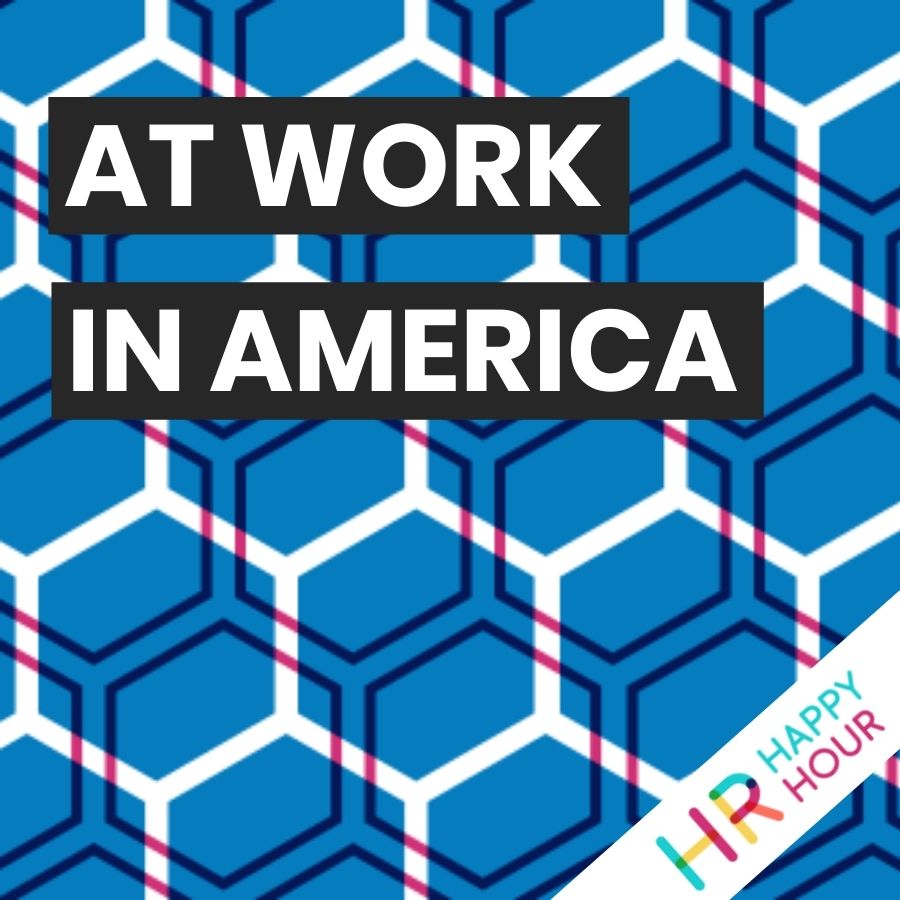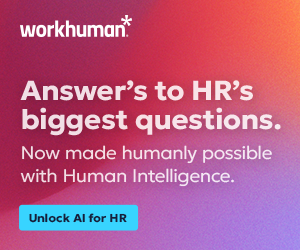How Second Chance Hiring Can Help Your Organization
Hosted by

Steve Boese
Co-Founder and Chief Data Officer of H3 HR Advisors and Program Chair, HR Technology Conference

Trish Steed
Co- Founder and Chief Strategy Officer, H3 HR Advisors
About this episode
This episode of the HR Happy Hour is brought to you by Paychex, one of the leading providers of HR, payroll, retirement, and software solutions for businesses of all sizes. The COVID-19 pandemic has completely changed how many people work, leaving millions of job seekers reevaluating their priorities and making it vital for employers to find new ways to keep them supported and engaged. That’s why Paychex surveyed more than 600 HR leaders and more than 2,000 employees at different-sized businesses across the U.S. to find out what employers are getting wrong when it comes to the needs of their workforce. What they found was a large discrepancy between what employees want, and what employers think they want, when it comes to their organizations. For a look at why employees say they’re leaving their current companies, and what you should be thinking about in order to attract and retain talent, download their findings here
This week, we met with Jeff Korzenik, Author of UnTapped Talent: How Second Chance Hiring Works for Your Business and the Community, to discuss the benefits of giving workers with criminal backgrounds a fair chance at employment.
– Story of JBM Packaging and their training program for people with criminal records
– How second chance hiring can help the labor shortage, and the risks involved
– The importance of leadership involvement with second chance hiring
– Financial benefits of hiring a candidate that has been “long-term” unemployed
Thank you, Jeff, for joining the show today! Remember to subscribe to the HR Happy Hour wherever you get your podcasts.
Transcript follows:
Announcer 0:09
Welcome to At Work in America sponsored by Paychex. We welcome a wide and exceptionally impressive array of guests, business leaders, HR leaders, academics, practitioners, consultants and authors to talk about the most timely, relevant and challenging issues that are influencing the workplace today. At Work in America digs in behind the headlines and trends to the stories of real people making a difference in the world of work. And now here are your hosts, Steve Boese and Trish Steed.
Steve 0:43
Trish, hey, it’s an exciting day. How are you? It’s our first new show, in a way I feel like it’s a brand new podcast.
Trish 0:50
I feel like it is too. I feel like we have the history of the last 12 to 13 years doing the show. But now we’re kind of in a new direction. I like the storytelling direction. So I hope everyone else enjoys it, too.
Steve 1:02
Yeah, I’m excited. HR Happy Hour was really good to both of us. And the Happy Hour still exists, right? It’s our network, all the shows exists under that umbrella. But we thought we would take this show in this new direction: At Work in America. And we’ve got a great topic and a great guest to kind of relaunch and re-kick off the brand, we’re talking about a really important topic, which is about the benefits and the importance of hiring people who’ve had some criminal history, criminal background, right, giving those people another chance, perhaps a second chance or really a fair chance, maybe the better way to say it. Our guest today to talk about that is Jeff Korzenik. He’s the author of Untapped Talent, which for benefit of the video I’m holding it up right now. I have my copy. We are so excited to welcome our special guest to the show, Jeff Korzenik. He’s also the chief investment strategist at one of the largest banks in America, where he is responsible for the investment strategy and the allocation of lots of money. He’s a regular guest on CNBC, Fox Business News and Bloomberg TV. We should probably get some other advice from Jeff after the show his perspective on the economy, markets manufacturing in the workforce are frequently cited in the financial business press. But may perhaps more importantly, at least for us today. He’s the author of the groundbreaking book Untapped Talent, how second chance hiring works for your business, and the community, which shares the business case and best practices for hiring people with criminal backgrounds. Jeff, welcome to the show. Great to have you.
Jeff Korzenik 2:33
Thank you so much. Delighted to be here.
Steve 2:36
Jeff, Trish and I were talking before the show with you a little bit. We’ve gone through the book, it’s such a great topic where we’re really, really interested in before we get into some of the nuts and bolts of what employers can really do to take steps into tapping into that this untapped talent pool, which they really need to do. I’d love to just get a couple of minutes from you on what brought you a banker who’s on CNBC talking about the markets of all thanks to this topic to to trying to make that connection between this untapped pool of labor and employers, what drove it?
Jeff Korzenik 3:13
So I really have two answers. I’ll give you the official answer. And then there’s a little bit of an unofficial answer I’d be happy to share. The official answer is, as you stated, my job is to oversee investments, but you can’t oversee investments without understanding what’s going on in the economy. And you can’t understand what’s going on in the economy. Without understanding thing what’s going on in the labor force. And background 2013-2014, I started to do a deep dive into why so many people were missing from the labor force and hot topic at the time, and came to the conclusion that social ills were of such a magnitude during that cycle, that they actually became economic ills and really major economic impediments to growth. And at the time that I had identified them, and criminal justice involvement is a big one. I’d also started to come across companies that had solved this they had figured out how to create viable pipelines of talent with people who had justice involvement in their lives. And as I traveled and collected the stories of these different companies, I found they all had essentially the same model. So I started sharing that model.
Jeff Korzenik 4:24
But the unofficial answer is that I grew up in Hartford, Connecticut, which is a very, very poor city. My father came from a very poor background, and he was the first in his family to make it, he did the heavy lifting in our family. He passed away in 2003. He was first of the family to go to college, son of immigrants, by the way, had degrees from Harvard and Yale, so did very well. And but never lost touch with his roots, and he would go and visit his old neighborhood under the guise of doing errands and as an eight or 10 year old I would go with him sometimes and when One of these visits, he talked to a friend of his home to store chatted had a nice conversation. As we walked away, my dad said, you know, my friend was in prison. And I asked for what and my father said for murder, a crime of passion. And then my father said something that stuck with me forever. He said, He’s done his time. Yeah. And I think that’s, that’s a value. And I want to make sure that people who have done their time, have the same opportunities to live the American dream that the rest of us have.
Trish 5:29
You know, thank you for for sharing both the professional side of why you’re doing it. But also that really, highly personal side, I think that a lot of listeners can relate to that we either maybe there is someone in our family who’s who’s served time and certainly has has done their time, to your point, or friends of family, your neighborhood people. I think, for me, personally, I was sharing this with you before the recording, but having kind of grown up working in human resources, my first job was working for Manpower International, and probably 80% of the workforce that we hired, or at least at my location was industrial. And we always hired people who had maybe criminal records, or even just arrests, right, maybe they weren’t convicted of something. But by and large, we found them to be very reliable workers, they were definitely wanting to kind of get their lives back on track. So for me, it’s it’s the idea that you’ve written about not just sort of the financial implications of this topic, but the human side of it. I’d love if you could maybe share a little bit before we really dig deep into kind of the the ins and outs of everything. But one of the things that sticks out is there’s a story that you talk about with JBM packaging. So if we could maybe start there, let’s start with the story, right. That’s the focus of the new podcast. And, and then we’ll kind of dissect how we get to that point of this being something that organizations could benefit from.
Jeff Korzenik 6:58
Sure, I had any number of companies I could have chosen as the case study, but many of the companies that had studied, have built from the ground up as of social enterprises, or they had a CEO who had family connections to justice involvement, or maybe a very, very deep faith commitment. And I wanted to use as an example, someone who just came at it purely from the business perspective. So the this is a company located about an hour, 45 minutes to an hour outside of Cincinnati, Ohio, they are in a county seat, but it’s a lot of somewhat rural county, there’s no public transit anywhere. And they had found like many companies had around 2018-2019, they run out of labor. They just couldn’t get any workers to fill their knees, let alone grow their company.
Steve 7:47
And this is a manufacturing company to by the way, this is not a big work from home kind of deal.
Jeff Korzenik 7:52
No, this isn’t, they make envelopes. And they’ve been doing it, a second generation family business. They’ve been doing it for 60 plus years, and well established. And they never run into this kind of problem before. And they tried everything bringing in retirees trying to get them back to work and tourism, high school is nothing, nothing stuck. And because the CEO at church had heard of a second chance employer in neighboring Cincinnati, thought he’d give it a try. And it became so successful not without bumps along the road, that they have expanded the practice, it has changed the entire culture to one that’s much more focused on innovation and much more mission driven across a broad number of categories. They’ve now have a quarter to a third of their workforce is they called fair chance. Second Chance people people with criminal records. They’ve set up a paid training program in a an Ohio State Correctional Facility, they actually had one of their workers have gotten into trouble was in a prison. They worked with Ohio Department of Rehabilitation correction, to have that individual transferred to this prison where they had good HVAC facilities. And he’s the trainer. And they don’t sell any product from there. They don’t want to be involved in quote unquote prison labor. They recycle any envelopes made there but they pay training. He’s got a pipeline of already trained individuals for their complex machinery. There’s a piece of this story that didn’t make the book because it happened after the book was published. This company’s business has gone so well that they’ve expanded they’ve opened a second facility. They chose to open this facility, not in the suburbs of Cincinnati, not in this town. They’ve opened it in inner city Cincinnati, the kind of place where businesses would not traditionally start up but they now understand that this is where their talent pool wise if you know how to tap it. So it’s just a fabulous example it required a lot of determination a tremendous amount of leadership. The CEO Marcus Sheanshang again second generation he purchased the company from his father, his father thought he was crazy. Everyone thought he was crazy. He made it work with the support of a great team that I’ve had the privilege of meeting.
Steve 10:09
Yeah. Jeff, the case study is fantastic. And it’s a big section like the middle part of the book that dives into what they did. And I was really struck by two things. One, how dedicated the CEO was to making this work, and almost having to sell the concept around to the leadership team, the managerial team, etc. That’s the first part, I’d love for you to comment on that part of it. And then second was the dedication of the HR team to this as well is because the book shares about maybe you could expand on a little bit, Jeff, how folks on the HR team at JBM are going to these prisons in person multiple times in a month, it sounded like to make those connections and build those pipelines. So first, maybe we’ll take the first part first, which is, hey, if you’re a leader, whether you’re an HR leader, or business leader, hearing this or will read this book, and want to get this maybe kicked off in their organization, talk a little bit about the kind of getting the right people on board process.
Jeff Korzenik 11:12
I think it’s critical for companies that want to do this, that you have to get executive leadership, and that as high up as you can go, if it’s a privately owned company, you get the owner, if it’s a public company, get the CEO president, the reason for that is there’s so much noise and reputation risk that people fear, it’s very difficult for people on the ground HR and talent acquisition professionals to take those risks, they need the cover of an executive saying it’s okay to do this. And so that’s critical, I do believe HR and talent acquisition professionals can help lobby higher ups for this, we need to consider this. But ultimately, for it to go forward successfully, it has to have the backing of the most senior levels at the company. So that’s been one, you know, one broad observation. And frankly, I, you know, I tell CEOs, that if you want to do this, you have to be very clear, it’s not fair to your HR professionals, for them to feel there’s career risk associated with the kind of risk taking anything innovative requires and so I you know, I see that, in terms of other executives and getting buy in, it’s really interesting, the group of JBM, like many others, you know, they were very uncomfortable, you know, maybe even to the point of afraid, you know, the first time I visited a prison, I had no idea what to expect. And it’s very intimidating, you know, these gates and fences and watch towers, and, you know, leaving your, your wallet, and your phone, in the car, and you know, all these kind of things that you have to go through. But it’s also infectious. Once you see people, once you start associating the concept of a resident of a correctional facility, as an actual human being. And once you have gone through the experience of helping someone rebuild their life, you want to do it more and more. I mean, we all love the Christmas story every year, right? It’s a story of redemption. We are drawn as human beings to stories of redemption. And this is a such an opportunity, it really becomes a privilege, I think, to help in this area.
Trish 13:34
Yeah, I’m glad you mentioned that because when you were kind of talking about the story, and as I’m recalling just reading it, one of the things that strikes me about not just hiring people, because I think you know, there are other companies where you hire people who might have a criminal record, or an arrest record, for example. But this really took it to that next step of showing both care and concern by going into the prison system, right. And you’re actually reaching out to inmates at a time when they might not have anybody. Everything in their life is is bad at that point. And so for this company, or companies like this, to go into the present system, and actually work with them as people, the human side of things showing care and concern showing them they have value. Could you talk a little bit about maybe just some experiences you’ve had, whether it be with some of the people who became employed or whether it’s through the employers? What does that feel like for the people actually going through it?
Jeff Korzenik 14:35
One of the things that’s been interesting for me on this journey is my own personal interaction with people who’ve been incarcerated and I came at this from other than my father’s friend that one brief meeting at age eight or 10. I don’t think I knew anyone who had been incarcerated or even arrested before this journey and I since have you know now have many friends who have been incarcerated and have had lots of interaction With this, this community, one of the things that has struck me is how many people told me who have who exited prison often for long terms and for very serious crimes that for which it was appropriate to be incarcerated, told me I went in at age 18. And I thought my life was over. And that’s a refrain I hear again, and again and again. And the sense of hopelessness of people in prison, or if you came to prison through gang membership, you know, you you never expected to live long anyway. You know, these are the kind of things one of my friends has a tattoo that says, Don’t cry for me across his chest, that’s half of a phrase, don’t cry for me, I’m already dead, is the full phrase. And it’s so common in, you know, the overwhelming characteristic of people who go into prison for the first time is that they are poor, they are young, and they are men. And for young men already have a sense typically of limited future. And once they are incarcerated, that goes from limited to zero future.
Jeff Korzenik 16:08
So having a company like JBM, or having some of the other companies that start this work, while people are incarcerated, is so valuable, not just because of the pipeline and creates for them, but the symbolism that scene. And I will share with you with my own book, this this influenced. The reason it’s a paperback and not a hardcover, as originally contracted, was because I wanted to address the sense of hopelessness, and a very generous philanthropist. Someone in the financial services industry, Steve Smith, generously has funded sending 500 of these books into prison into prison libraries. And we do this through a Utah based nonprofit called Bix, books inside here, you cobble these things together. And I did that because I, and I’ve been writing about this for other publications. Barron’s financial news magazine, for instance, I got a letter from prison is a federal prison in Colorado. And this, this inmate resident there wrote me, he said, I just want you to know that your Barron’s article on this hangs in our prison library wall, and it gives all of us hope. And I realized that my book could in part be a message of hope. So you’ll see in the very start of the book is a I guarantee you this is the only business book ever written that starts with a section called a note to the currently incarcerated. Yeah, I saw that. Yeah, yeah. And the message is very simple. You think you’re a burden, you’re not a burden, you’re a resource, and we’re all going to need you. And I want that message out there. And so anyway, but to do that, you can’t send hardcovers into prisons because they can be weaponized, it’s generally believed. And so I worked with HarperCollins leadership, my publisher, and we demoted my book from a prestigious hardcover to a paperback and I was happy to do it.
Steve 18:01
I actually like it. I prefer the paperback just for me. Just carry it around. So easy to lift. Yeah, I thank you as well. I just wanted to just mention something real quick. In the book, it gets back to Trish what you were talking about a second ago there in the in the chapter in the book, which is the case study of JBM packaging, which is the company we’ve been talking about. The one of the HR people who’s heavily involved in the programmer name’s Ashley Cordell in the book, she there’s an anecdote in here where she checks in with one of the employees that JBM is hired through this Second Chance program or Fair Chance program, as they call it, and and maybe that’s employee was having, you know, a little bit of trouble which honestly, pretty much every employee does at some point or another right? And she checks in with them just to see how he’s doing. And in the book, here’s the line before answering the employee exclaimed with surprise quote, I’ve never had anyone asked me Are you okay? So this gets into Jeff what you’re talking about a lot of these guys and they’re mostly guys, right, as you say, just haven’t had they’ve come up in tough circumstances, maybe been poor, maybe not had the best family life maybe just didn’t have that kind of loving, nurturing background that we have. A lot of us quite frankly also put me in this category took for granted right and have taken for granted in our life. So I wanted to bring that up because that was a really kind of moving little story that was in that chapter.
Jeff Korzenik 19:18
And, you know, I’m constantly moved it’s hard for me to keep my you know, dispassionate business face on when doing this. My friend John Koufos, has made some wonderful contributions to the book. He’s a well known and regarded justice reformer formerly incarcerated. It himself he had substance abuse challenges, and he said, you know, be sure employer to tell employers to thank their employees when they do something right because it may be the first time they’ve ever been thanked in their life. And you realize in I never condone, nor excuse the act, the criminal act right, but it is right that there be consequences for those acts, but at the same time, you can recognize that many of the people who are justice involved were victims themselves often in childhood.
Trish 20:09
Yeah, thank you for sharing these, I think it’s so important to just recognize the emotion that comes behind it, right? This isn’t just a stunt, just a business book, right? As you’re, you’re talking and it’s like I’m tearing up, because I’m thinking of actual people I’ve worked with over the years who were very moved when they had any amount of attention or value or hope given to them right? Through an employer. Could you maybe talk you touched a minute ago on some of the risks? And what would you say if I’m an HR leader, I’m going to my CEO, right, trying to get maybe something like this going, or at least even you know, the initial steps of this going in my organization? What would you tell them about? Answering that question about risk, right? Because sometimes someone might have committed something that’s very serious, right? It doesn’t mean they cannot be a good worker in the future. It doesn’t mean they don’t deserve a chance. So what would the message be to that?
Jeff Korzenik 21:08
I think the first thing is acknowledgement, there are three major concerns that come out. One is safety/liability, are you endangering your customer or your teammates with this hire and taking on subsequent additional legal liability and financial liability? The second one is a fear that you won’t get a good employee. And it’s terrible to have a bad employee. And the third is that somehow, the fact gets known that you’re hiring people with records and it causes a reputational risk that scares away customers. And each of these can be addressed. So I think the first step is this acknowledgement. Here’s what you’re concerned about. Let me explain how we can address each of these. One, to say you’re going to hire someone, a criminal with a criminal record doesn’t mean you’re going to hire everyone with a criminal record. There, there are 19 million people within the United States with felony convictions. I’m not talking about hiring all 19 million. If you can’t find a handful out of that 90 million. I’m not sure the problem is the 19 million.
Steve 22:16
The case study we’ve talked about a lot, it’s featured in the book had some, some guidelines about hey, we’re not going to hire these folks. Like if you were a murderer, etc, there were a couple of them.
Jeff Korzenik 22:27
Yes, crimes against women and children was a no go for them. Other places, it’s very common for employers to start with a lot of no goes. But they tend to loosen it over time. And what I you know, I even tell employers, and this is, you know, for further along in that conversation, don’t automatically exclude people who are convicted of crimes of violence. Because that doesn’t mean that they are necessarily violent people, particularly today, they might have been when the crime was committed decades ago, they might not have been, it could have been wrong place wrong time. My friend, Jeff Brown is one of the employers I highlight. He’s got 500 of its 2500 employees are people with records. He, you know, he said, look for a lot of these people, particularly young men, the drug trade is their only path to getting ahead. Yeah, if you’re in the drug trade, like any business, you want to protect your inventory. And that means having a gun and young men with guns, things are gonna happen. So at any rate, you as the employer continue to control who you let in and your process of examining that record, is your protection from legal liability. In terms of the you know, will it will this be a good employee or to use my friend Rob Perez, who runs a second chance bakery and cafes in Lexington, Kentucky, he says, you know, Second Chance doesn’t mean second rate. But he had to face customers who weren’t afraid of their safety, they were afraid of a lousy product or experiences cafes. And then he’s actually listed now he or had to earn that respect, it can take time. But he is one of the top rated Cafe bakeries in the United States on the on the Yelp reviews because the history is if you do this, right, you don’t get just an employee, you actually get an exceptionally dedicated and loyal employee. And that’s a recipe for good performance, not bad performance. And then that reputation piece. You know, I think that’s changed over time. There might have been a point in time where, gee, this company hires people with criminal records. They must be you know, a problem company. Now, I think people understand that companies that are helping solve societal problems as part of their business practices are companies you want to do business with. And certainly many employees, particularly millennial and Gen Z employees want to work for companies that are involved in more than delivering profits to shareholders. So I think you know, there’s three issues, but they’re the three ways of addressing them. And you know, each one takes a little is very company specific. But those are the broad guidelines.
Trish 25:08
Thank you for giving those because I think that’s important if they if you come at it sort of prepared with what someone’s fears might be, it’s going to just help make that conversation happen and flow much easier. As you were talking to you, I was thinking about a part in the book, I won’t be able to quote it exactly. But you were talking about, you know, we, all go through life everyday, we don’t know how many people we’re coming into contact with that have a record of some sort that had been arrested or have been convicted of who knows what, and yet we somehow successfully live through the day we go get our groceries, we go in, you know, Ubers and whatever, right and, and it doesn’t mean that you don’t have a good experience with that person, it doesn’t mean that they are not a loving person, or a hardworking person. So I appreciate that you’re shedding light on the fact that these are very valuable.
Steve 25:58
I’ve met some really awful people who’ve never spent a day behind bars, right.
Jeff Korzenik 26:05
Right, there are lots of people who have, you know, perfectly good, perfectly clean records, who are absolutely toxic employees.
Steve 26:14
I want to take a pause for a second we catch our breath, I want to thank Trish, our friends at Paychex. This episode of At Work in America is brought to you by Paychex – one of the leading providers of HR, payroll, retirement and software solutions for businesses of all sizes, the pandemic has completely changed how many people have work, leaving millions of job seekers reevaluating their priorities and making it vital for employers to find new ways to keep them supported and engaged. Paychex surveyed more than 600 HR leaders and more than 2000 employees at different size businesses across the US to find out what employers are getting wrong when it comes to the needs of their workforce. And what they found was a large discrepancy between what employers want and what employees think they want. And when it comes to their organization. So to get into this and look at what’s happening, why employees are leaving, and this gets to the heart of some of what we’re talking about. Companies can’t find employees, what you should be thinking about in order to attract and retain talent, you can download the findings at payx.me/attractingandretainingtalent. And we’ll put the link in the show notes. And thanks to our friends at Paychex.
Steve 27:22
Jeff, I can’t let this conversation end without getting into context. Because I before the show I share with you I’m a big labor market geek. And it is a perfect storm in the labor market. And you also say right in the book jobs, it’s like page one of the book, I’m gonna read this, the argument for a second chance hiring must stand alone as a business case to be sustainable and scalable. And I totally buy believe you with that too. Like you, this can’t just be this is the right thing to do. Right for for most organizations, right JBM had to solve that problem of, you know, getting staff because they might have, they might have closed down honestly, if they couldn’t have staffed up that those facilities in Ohio, I’d love for you to talk a little bit about kind of a little more the business case behind this and maybe a little bit of the context that you found in the labor market back in 2013. When you started looking at this, and what’s happening now 10 years later.
Jeff Korzenik 28:17
Yes, back in 2013, we had a labor shortage already surfacing in certain industries, it was most pronounced in manufacturing. And when I started digging deeper, I found it wasn’t for lack of applicants, it was for lack of applicants who could pass a drug test. And for many manufacturers and other types of industrial companies. This is not this is a matter of workplace safety. You cannot let someone in right you can’t be flexible on this because you endanger your your workforce. And as I started to explore that, I assumed back then I assumed it was pot was the big issue. It and I started hearing no it was pills. And that’s how I started how I recognize that the opioid epidemic was a this despite, beyond being just this horrible family and community tragedy was also a workforce issue. And obviously something that tends to bring out a lot of justice involvement, but it is spread from there. And it became really noticeable in 2018. We flipped over from having traditionally in the US economy, you have more more job seekers than you have job openings. And at some point in 2018 it flipped over we had more job openings than job seekers and it persisted for something like 14 months, we’ve never seen it persist that long. And then you know that pandemic kind of blew everything up. But as we come out on the other side of this, the the what I used to what I used to call and may have called in the book that looming labor shortage you know, this labor shortage is coming.
Jeff Korzenik 29:55
Remember the book came out in the middle of the pandemic we had, you know, really high single digit digit unemployment at the time, and people were worried about anyone. And I’m out there saying it’s a labor shortage that’s coming. And I said that because it’s baked in by our demographics. At the time, the numbers were that we expected 10,000 Baby Boomers to retire each day for the next for the following decade. And you just didn’t have once the millennial generation was all in, you just didn’t have enough. We didn’t have we didn’t have enough births 2030 years ago, right? Quite simply, it was really hard to change that. So what happened during the pandemic is, we accelerated all these trends. And you had in particular, the the older workers, retired early St. Louis Fed estimated that 2.4 million people have retired early, some may unretire, but that’s a huge loss. It’s not just a loss of bodies, but particularly in some of these fields, like the trades, manufacturing, you’re losing your really real reservoirs of experience, because of the what happened to us manufacturing 20 years ago, you kind of miss missing that middle link. So losing them is losing a lot. And then you had some women, some men and women, but but more typically women statistically dropped out to watch over children who couldn’t go physically to school, some are staying out. Those many, many of those are coming back. And then you just stopped having enough coming in from births 20 years ago. Yeah. And so all of this has left us in a point where current numbers are something like 10 point 9 million job openings in the United States, and 6.3 million job seekers, we’ve never had a gap like this. And think about that, right? If you if you let’s say you get all those 6.3 million job seekers to come and take those opening jobs, you’re still short four and a half 4.6 million workers.
Steve 31:52
And 4 million people are quitting their jobs every month on month on month, right?
Jeff Korzenik 31:56
Right, and then many are getting reemployed. Yeah, that goes on and all that, but we have a structural labor shortage. And yes, technology can be part of the solution. But ultimately, you can’t grow your economy, if you don’t, aren’t able to grow your workforce, you can make up for some of it with productivity. But it’s really hard to make up for, you know, losing this many workers. So this is something that we’ve got to look at, we’ve got to say, not, how do we trade the people, you know, amongst each? How do companies trade one across the other of the existing employees, you have to look at people who aren’t even counted in the job seekers who don’t know about the opportunities, who’ve been marginalized completely from the labor force.
Steve 32:39
And that’s the point, right, in this world of declining labor supply, this is an opportunity to expand that supply to bring in people who are just not currently in the labor pool and bring them in, right?
Jeff Korzenik 32:51
Correct. And it’s not the only solution. You know, let’s get retirees coming back, let’s help working parents, you know, get flexibility that allows them to stay or come back to the labor force. But when you took take a look at your starting point is 90 million people with felony convictions, and we know the vast degree to which they are overlooked, and have dropped out or get into because they have no other alternatives, get back into this cycle of crime and what a waste and we can no longer afford to waste that kind of talent.
Trish 33:26
I think too, when you’re talking about the, you know, the example the case study in the book, where if you’re going into a prison system, and actually training people, you know, that’s something a lot of companies don’t even think about doing. And so if you do have a company where maybe the skills are very precise that someone needs to have, and you can’t find that, why not go train them, right. And it will build up sort of, I don’t know, an allegiance and and connection to your company, before they’re even out so that when they come out, they’re going to be not only trained, but they’re going to want to work for your company. Could you maybe talk about some of the financial benefits of hiring people who either have a record or maybe have, you know, have been arrested and not convicted? There are certainly some financial aspects to this too, that are very beneficial to the company.
Jeff Korzenik 34:20
Absolutely. And they’re very evident today, when you have to Steve’s point these this really the the great resignation, right? When and that is forcing all these companies to endure very high costs because of that, and those costs are certainly in the 1000s of dollars, even for fairly low level employees disruptions to work the lost productivity because you got to retrain someone, maybe hard costs of recruiting someone as someone else. And you also have losses of trying to build a corporate culture all these things turnover is a really bad thing for companies and and very, very difficult. What we have found with every piece of evidence points to is If you hire people who have been overlooked and know they’ve been overlooked, and you give them an opportunity, and then there’s a second piece to this, you also have to make sure you are sensitive to the gaps. They might have transportation, housing, mentorship, if you give them the tools to thrive, you get an exceptionally loyal employees or employees with very low turnover costs a very low turnover and turnover costs. And then if you have someone who really cares about their job and stays with you, they tend to be very productive employees and very productive employees tend to be very profitable employees. So it’s a big win. But I have to emphasize you got to do it, right. There are people who business executives who have come to me and said, Yeah, but that wasn’t my experience. And when you dig down into what they were doing, it was not that they were either in a tight labor market and said, Oh, I guess I’ll lower my standards, and didn’t go looking for talent, they weren’t looking for bodies, or they were focused only on the Work Opportunity Tax Credit, which is a fine thing. And companies that do this should absolutely take advantage of it as a peripheral benefit, not as the core reason, right?
Jeff Korzenik 36:11
If you’re just looking for a cheap employee, you get what you pay for. I call that in the in the book, and in my work, I call that the disposable employee model. You don’t care about like tend not to care about longevity, you know, it’s cheap, but you’re looking for someone who’s cheap will stick around for a while. And low, low skilled job. The more common problem that businesses have come across is they didn’t understand this population and their special needs. So they would be discriminating in a positive way in trying to select people who are good fits and who cared. But they didn’t understand the roadblocks that these employees would have. And they didn’t understand how to fill the gaps. Right. Any employer has a talent acquisition model, I want to find the people who fit and I want to empower them to thrive and be great employees. And the challenge here is that the what it takes to thrive may be very different from this popular for this population, not more expensive, lots of partners. In fact, we’ll help you provide it. Eight government agencies nonprofits that will help provide those wraparound services, but you as an employer have to know so what would happen in that model, which I call the undifferentiated model. You seek out good employees, you get people who care. But then half of them can’t succeed because they don’t have the tools to succeed. And they might go straight, right? They did, their car broke down, they don’t have money for repair. They don’t know what to do, because they’ve never had mentorship or never had a real employment. So they don’t call in, they just don’t show.
Steve 37:47
I’ve got to meet with my parole officer on Tuesdays and Thursdays from one to two, right? Like, yeah.
Jeff Korzenik 37:51
yeah, I’ll tell you a terrible story of a Indiana construction company that hired had great success hiring people with records and they had one employee who was very, very dedicated, great employee, that we have a job out of state we’d like you to to do that. And the employee didn’t want to disappoint his employer was so dedicated, didn’t know how to navigate the fact that he didn’t have permission to go out of state. So he was the term is violated parole, he was violated and went back to prison. Right here he is on track, rebuilding his life, a great employee and employer who appreciates him. But he didn’t want to employ a disappointed employee didn’t know how to articulate that. And these are the things that the employers who do this right, learn from the get go. They ask you, what’s your what’s your schedule meeting your appeal, your parole probation officer? What are restrictions you have? What’s your housing situation, what’s your transportation situation, and these can be just part of the normal intake for all employees. And it allows you not just to serve this specific population, but really anyone who’s coming out of deep poverty will have a lot of these challenges.
Steve 39:01
There’s some great examples in the book from the JBM case study as well. Some other examples of specific things that organizations can do about checking in about questionnaires and things like that, to try to avoid horrible situations like the one you just described. Some of these things are gonna happen, right? That’s just that’s just the way probably, but to try to do the things you can do to minimize their their likelihood is is important thing. And there’s some great examples in the book that can help folks. Go ahead, Trish,
Trish 39:31
I was gonna say specifically, if nothing else in the back of the book, the appendix section, has actual job applicant screening questions, has the recruitment documents that they used has all different resources, how to do check ins with people. So if you feel like you don’t have a place to start, it’s a good place to start and has lots of resources. So I love that you included that. So it’s not just talking about it. You’re actually operationalizing what you’ve talked about.
Jeff Korzenik 40:00
The generosity of JBM, they shared their documents with me, allowed me to publish those as part of the book. And what I found is that second chance employers, so get the societal and economic benefits that they are willing to share, you know, this is a trade secret, in a sense, is Jeff Brown, the owner of the supermarkets chain, and in it’s a great second chance employer in Philadelphia, 500 of their 2500 employees, set up a nonprofit, that trains for his company, but also trains for his competitors. Right. Think about that you hit his nonprofit, his training employees for his competitors, but he gets he operates in actually what half of the stores are what would otherwise be food deserts. Yeah. And he offers these great, clean, well stocked grocery stores. And he gets that if everyone in this community is prospering. Yeah, he’ll prosper to and that’s how all of us should see this.
Steve 40:59
Seeing the bigger picture, Jeff, we could go on for another hour. I want to be respectful to your time. The book is Untapped Talent, How Second Chance Hiring Works for Your Business and the Community, we will obviously put a link to how you can get the book in the show notes. Jeff, is there anything else you would maybe just advise our audiences, largely HR professionals, HR leaders, they’re thinking about this or maybe have convinced whoever they need to convince this is a good thing. But really JBM talks a lot about having to find the right partners and different governmental facilities and different institutions cetera, was there one or two things you’d say, hey, think about this, do this or go there? Because I didn’t look obviously.
Jeff Korzenik 41:41
Yeah, you know, I think I would, I would just start with, you have to recognize this labor shortage isn’t going away. And that this is going to require an investment of time and effort. Maybe not money, but time and effort. But But what good thing does it right? I’ve never known anything in business, the business world is just falls into your lap, you got to work for it. And this is no different. And there’s no sugarcoating the challenges of this. But as my friend Ray Dalton was the second chance employer was just did an amazing job says, Second Chance employees are more work upfront, but they’re worth it. And I think that can be said of this of this process. I’ll also highlight the work of the Second Chance business coalition. They are really focused on ultra large companies. But their website also has a lot of resources. They’ve partnered with SHRM, the Society of Human Resource Management, many of your listeners are sure members such as the getting talent back to work sort of certificate. Last, I don’t know if this has changed, but I believe it is free. So it’s a certification program offered by SHRM, it’s very rigorous, extremely well done. And they believe in this and so they’ve made it free for both members and actually for non members as well.
Steve 42:57
Oh, that’s great, great stuff. Jeff’s been fantastic. I really appreciate you taking the time to join us. I love reading the book. I love the story. And just many, many thanks for sharing that with us today. I really appreciate it.
Jeff Korzenik 43:09
Delighted to be with you and your listeners. Thank you.
Steve 43:12
All right, Jeff. That’s Jeff Korzenik, author of Untapped Talent. We’ll put the link in the show notes. I highly recommend it. If you’re an HR business or leadership. Great, great stuff there. Trish good stuff, loved it. Good job on the first At Work in America, how about that?
Trish 43:26
I know it was really fun. And you know what, I am not a huge reader lately, just because we get so tied up in your this was really inspiring, quick, interesting read, I have to be honest with you, it you know, two to three days I had it done and I’ve highlighted it to that. It’s also one of those books. I think if you’re like me, you can highlight really good sections and then go back to them when you need them. So it becomes almost like a textbook as well. So it’s interesting to read, but then you can actually go back and like I said at the end operationalize a lot of these things. So yeah, really, really good training for HR people.
Steve 44:02
All right, great, great stuff. Thanks, everybody for listening. Great to be with you, links in the show notes. Thanks to our friends at Paychex, of course, for our guest Jeff Korzenik, for Trish Steed, my name’s Steve Boese. We will see you next time. And bye for now.
Transcribed by https://otter.ai
Talk to us
If you want to know more about any aspect of HR Happy Hour Media Network, or if you want to find out more about a show topic, then get in touch.










